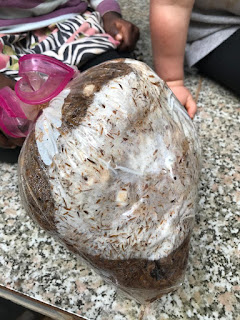28.2.21
Mushrooms Worth a Field Trip
By Erica Ause
Some weeks ago, our school was invited to a field trip. Madame Thérèse, a woman who has taught Kirundi and other cultural lessons to our team, invited us to her home to experience the three-day process of preparing to grow mushrooms. She said it is not a very common activity here, so I felt fortunate to learn about it.
The first day, Jess and I went to see the beginning stage of the process. Step one was to mix together raw cotton, which Madame Thérèse bought from someone in another province, and rice husks. For those of you, like myself, who don’t know, rice grows inside a casing. That casing is taken off, the rice is sold, and the husk is either discarded or used. In this case, they used the husk (the brown material pictured) to provide the nitrogen that is needed for the mushrooms to grow.
Once the materials were mixed, they were packed into a big white sack and placed into a barrel. The men helping made a hole in the middle into which they poured water and left it to soak overnight.
The second day, Jess and the Harlings went back to see the next step. On this day, the purpose was to sterilize the mixture so that nothing except the mushrooms would grow in the bags. They packed freezer bags as full as they could with the cotton and rice husk mixture, tied off the bags, and then placed them back into the very large barrel with water in the bottom. They heated the water to sterilize the bags.
On the third day, the students joined us to see the final step. This was the day for planting the mushroom seeds into the bags. The team that was demonstrating set out candles to sterilize everything they used, and to keep the microbes and flies away from the bags. They used pointed sticks to poke four holes in each bag, then used spoons to shove the seeds into the holes. The seeds were in a white material that we never quite figured out the purpose for. Once the seeds were planted, they put tape over the holes, presumably to keep the moisture in the bags while the seeds germinated. After about three days white spores would cover the inside of the bag. When this happens, it is time to poke tiny holes so that water can get in, and the mushrooms can grow out. The bags are watered twice daily, and after about two to three weeks, there should be mushrooms growing all over the outside. Amazing!
The people teaching us were also kind enough to let the students and teachers help in the planting process. It was definitely different than the planting I have done before, but we really enjoyed participating and seeing how much work it takes to produce mushrooms which are safe to eat.
The bags that the students helped with are now sitting in a dark, damp place on the compound working hard to grow some mushrooms of their own. Pictured above is what they looked like after about a week and a half. We can’t wait to see what happens next!
What stood out to me most was that it takes three weeks, raw cotton and rice husks (which are two material I barely knew existed) to grow something it takes me 30 seconds to buy in the states. From the start, I have been surprised by how much longer the process of preparing food takes when everything comes almost straight from the plant to my kitchen. Even peanuts come needing to be roasted, which I never knew was a necessary step before. To see the work and care that goes into growing mushrooms was truly amazing. Not to mention that Madame Thérèse and the others were willing to spend the time teaching us how it is done. I have seen this selflessness many times here, and I hope to learn and absorb it into my own life.
Subscribe to:
Post Comments (Atom)













1 comment:
I had no idea how this worked!! Very interesting!
Post a Comment